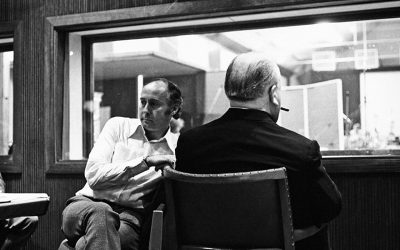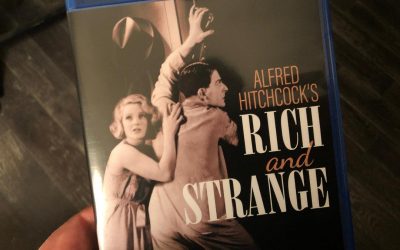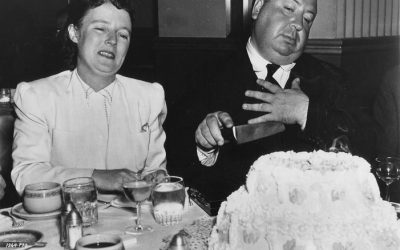The auteur did not work alone.
The source for information on Alfred Hitchcock and his writers—and the book about his most frequent writing collaborator in Hollywood, John Michael Hayes.
Hitchcock said:
“The most enjoyable part of making a picture is in that little office, with the writer, when we are discussing the story-lines and what we’re going to put on the screen. The big difference is that I do not let the writer go off on his own and just write a script that I will interpret. I stay involved with him and get him involved in the direction of the picture. So he becomes more
than a writer; he becomes part maker of the picture.”
Hitch’s Golden Era
From 1954 to 1964, eleven feature films and twenty television episodes directed by Alfred Hitchcock were released. This was by far his most prolific period and artistically his most successful. The era began with his collabration with the writer John Michael Hayes.
The Hitchcock-Hayes Collaboration
The Hitchcock-Hayes collaboration produced four motion pictures in two years—Rear Window, To Catch a Thief, The Trouble with Harry, and The Man Who Knew Too Much—and proved to be one of the most successful director-screenwriter pairings in Hollywood history.
The Hitchcock-Bennett Collaboration
Beginning with The Man Who Knew Too Much in 1934, Hitchcock and Bennett closely collaborated on a string of innovative thrillers which combined a certain wit, freshness and originality that became trademarks of Hitchcock’s style. Bennett’s true genius was at story construction, and his scenarios were built on many devices now regarded as “Hitchcockian”—the ‘MacGuffin’, the double-chase, the charming villain, and the use of exotic locales woven dramatically into the plot.
The Auteur Theory
A lot of people embrace the auteur theory. But it’s difficult to know what someone means by it. I suppose they mean that the responsibility for the film rests solely on the shoulders of the director. But very often the director is no better than his script.
Settling the Score: The Music for Frenzy
The Long-Awaited Release of Henry Mancini's Unused Score I was excited when I learned that Quartet Records was...
Strange Sounds in Kino’s Rich and Strange Blu-ray
A Major Audio Problem with Kino's Blu-ray of Alfred Hitchcock's Rich and Strange In terms of picture quality, Rich and...
Alfred Hitchcock’s 117th Birthday — #Hitchcock117
Just as an off the cuff, here are my one hundred and seventeen reasons to celebrate Alfred Hitchcock on this day:...
-
FAQsDid Alfred Hitchcock write his own movies?
Although he rarely did any actual “writing”, especially on his Hollywood productions, Hitchcock supervised and guided his writers through every draft, insisting on a strict attention to detail, and a preference for telling the story through visual rather than verbal means.
Which Alfred Hitchcock movies are based on true stories?Although there are elements of true crimes in many Alfred Hitchcock films, only The Wrong Man (1957) is credited as being based entirely upon a true story. The Lodger (1926) takes its inspiration from Jack the Ripper. Shadow of a Doubt (1943) was inspired by a true-life strangler of women named Earle Nelson. Elements of the case of Dr. Hawley Harvey Crippen found their way into Dial M for Murder (1954), Rear Window (1954) and Vertigo (1958). The crimes of Ed Gein inspired the novel Psycho (1960). The infamous Leopold and Loeb murder inspired Rope (1948). The defection to the Soviet Union of British spies Guy Burges and Donald Maclean was an early inspiration for what became Torn Curtain (1966). And there are countless other moments from Hitchcock films that were inspired by real incidents and people.
Which screenwriters worked with Alfred Hitchcock the most?Eliot Stannard has the most screenwriting credits on Alfred Hitchcock’s feature films, having written seven of the director’s first eight silent movies. Charles Bennett comes in second with credit on six individual screenplays. Bennett also has the added distinction in that his play Blackmail was the source material for Hitchcock’s film of the same name and he also receives a story credit on Hitchcock’s remake of The Man Who Knew Too Much (1956). John Michael Hayes has the distinction of being Hitchcock’s most frequent screenwriter in Hollywood, having written four films consecutively for the director from 1953 to 1955. And on the small screen, Francis Cockrell wrote six teleplays directed by Alfred Hitchcock (five for Alfred Hitchcock Presents and one for Suspicion).
Did Alfred Hitchcock storyboard every single shot in his movies?A trained artist and draftsman, Alfred Hitchcock himself did frequently sketch scenes and individual shots for the benefit of his production crew (cinematographers, production designers, art directors, etc.). Although many scenes and sequences for his films were meticulously storyboarded—most famously for Psycho and The Birds—it is a myth that Alfred Hitchcock storyboarded every single shot in his movies.
Of his own movies, which was Alfred Hitchcock’s favorite?Alfred Hitchcock is most often cited as referring to Shadow of a Doubt as his personal favorite of his own films. He did also cite Rear Window, The Trouble with Harry and Vertigo as being favorites on numerous occasions.



